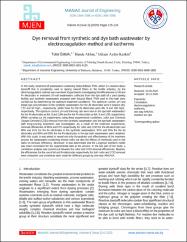| dc.description.abstract | In this study, treatment of wastewaters containing Setazol Black TNN, which is a reactive diazo dyestuff that is prevalently used in dyeing natural fibers in the textile industry, by the electrocoagulation method was examined. Experiments investigating the effectiveness of Al and Fe electrodes in treatment of real wastewaters collected from the dye bath of a yard dyeing facility and synthetic wastewaters prepared with Setazol Black TNN used in this bath were carried out by determining the optimum treatment conditions. The optimum current, pH and initial dye concentration in the synthetic wastewaters for the Al electrodes were 8 ampere (A), 7.57 and 50 mg/L, respectively, while these for the Fe electrodes were 8A, 9 and 100 mg/L, respectively. The optimum current, pH and thinning rate were seen in the dye bath wastewaters for the Al electrodes as 8A, 8 and 1/60 and for the Fe electrodes as 8A, 9 and 1/30, respectively. While carrying out the experiments using these experimental conditions, color and Chemical Oxygen Demand (COD) removal from the synthetic wastewaters and the dye bath wastewaters with long-running treatments was investigated. As a result of the treatment experiments, removal efficiencies of 96% and 57% respectively for color and COD for the Al electrodes and 99% and 61% for the Fe electrodes in the synthetic wastewaters, 87% and 55% for the Al electrodes and 89% and 55% for the Fe electrodes in the dye bath wastewaters were obtained. With this study, it was aimed to reveal not only the position and effectiveness of the treatment process for wastewaters containing intense color but also the effects of chemicals used in dye baths on removal efficiency. Moreover, it was determined that the Langmuir isotherm model was more convenient for the experimental data in the process. In the last part of the study, a correlation analysis was carried out between the color and COD removal efficiencies. Besides, the efficiencies for the use of Al and Fe electrodes respectively for both color and COD removal were compared, and comments were made for different groups by one-way ANOVA.. | en_US |



















